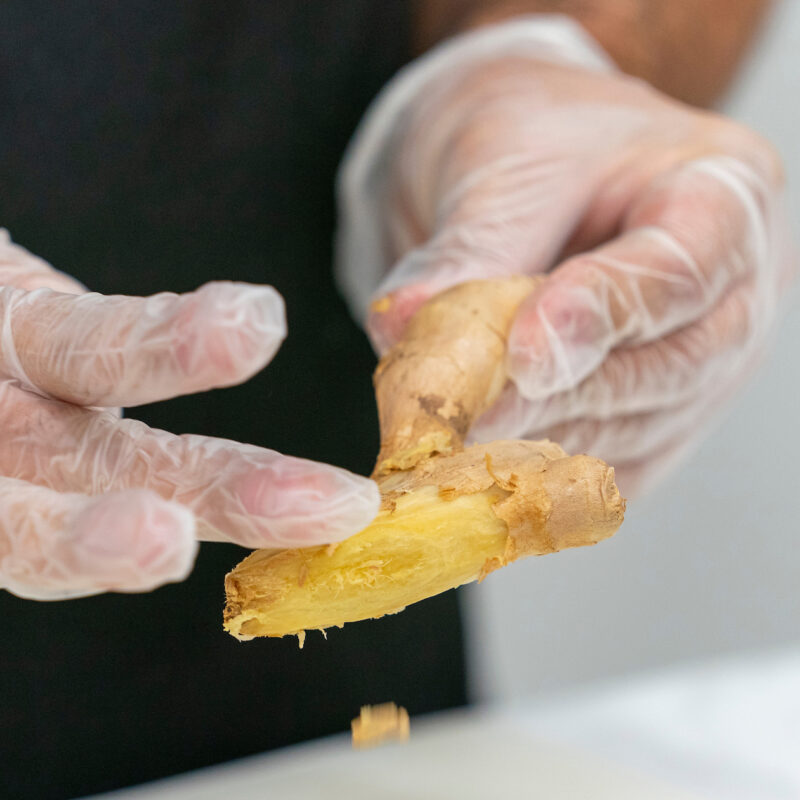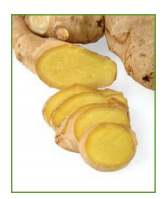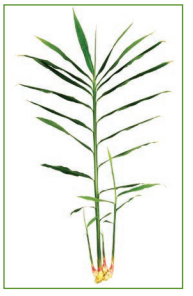Ginger
By: Joseph Masabni and Stephen King

The ginger plant (Zingiber officinale) is grown for its aromatic, pungent, and spicy rhizomes, which are often referred to as ginger roots.

The main active components in ginger are gingerols, which are responsible for its distinct fragrance and flavor. Gingerols are powerful anti-inflammatory compounds that can help alleviate the pain caused by arthritis. Studies have also shown that ginger helps boost the immune system, protect against colorectal cancer, and induce cell death in ovarian cancer.
The texture of ginger rhizomes is firm, knotty, rough, and striated (banded). Depending on the variety, the flesh may be yellow, white, or red. The skin is cream-colored to light brown and may be thick or thin, depending on the plant’s maturity at harvest (Fig. 1).
Site selection
Ginger thrives best in warm, humid climates. Choose a site that provides plenty of light, including 2 to 5 hours of direct sunlight. Ideal spots are also protected from strong winds.
Soil preparation
The best soil for ginger is loose, loamy, and rich in organic matter. Loamy soils allow water to drain freely, which will help prevent the rhizomes from becoming waterlogged. Thick mulch can also provide nutrients, retain water, and help control weeds.
Planting
Before planting, cut the ginger rhizome into 1- to 1½-inch pieces, and set them aside for a few days to allow the cut surface area to heal and form a callus. In early spring, plant parts of the underground rhizomes. Each piece should be plump with well-developed growth buds, or eyes.
A good source of ginger for planting is fresh rhizomes from another grower. If you are buying ginger from a store, soak the rhizomes in water overnight because they are sometimes treated with a growth retardant.
Plant the rhizomes 6 to 8 inches apart, 2 to 4 inches deep, and with the growth buds pointing upward. They can be planted whole or in smaller pieces with a couple of growing buds each. Ginger plants will grow to about 2 to 3 feet tall.
Fertilizing
If the soil is less than ideal, add a slow-release organic fertilizer at planting. Afterward, liquid fertilizer may be applied every few weeks.
These soil amendments are especially needed in regions of heavy rainfall, where rain can leach essential nutrients from the soil. You can also add compost, which will supply nutrients as well as retain water in the soil. Ginger roots benefit from fertilizer containing high levels of phosphorus (P). Have the soil tested first and amend the soil before planting according to the test recommendations.
Watering
Do not allow the plants to dry out while they are actively growing. As the weather cools, reduce watering. This will encourage the plants to form underground rhizomes. In dry areas, mist or spray plants regularly. Always avoid overwatering.
Harvesting

Ginger can be harvested by digging up the entire plant (Fig. 2). Although it may be harvested at any stage of maturity, the best time is when the plant is 8 to 10 months old. After harvest, choose rhizomes for replanting and replant them promptly.
Ginger is typically available in two forms:
- Young ginger is usually available only in Asian markets and does not need to be peeled.
- Mature ginger is more readily available and has a tough skin that needs to be peeled.
Store fresh ginger in the refrigerator or freezer. If left unpeeled, it can keep for up to 3 weeks in refrigeration or up to 6 months frozen.
Nutrition
Ginger is a good source of copper, magnesium, manganese, potassium, and vitamin B6. Historically, it has been used to relieve symptoms of gastrointestinal distress. It is also safe for pregnant women who are experiencing nausea and vomiting.

Serving
When preparing ginger, peel off the skin with a paring knife. Ginger can be sliced, minced, or julienned (Fig. 3).
The level of flavor that ginger delivers to a meal depends on when it is added during the cooking process. Added early, it will give a hint of flavor; adding it toward the end will bring about a more pungent taste.
Download a printer-friendly version of this page: How to grow Ginger
Download this publication in Spanish: Cómo cultivar jengibre
